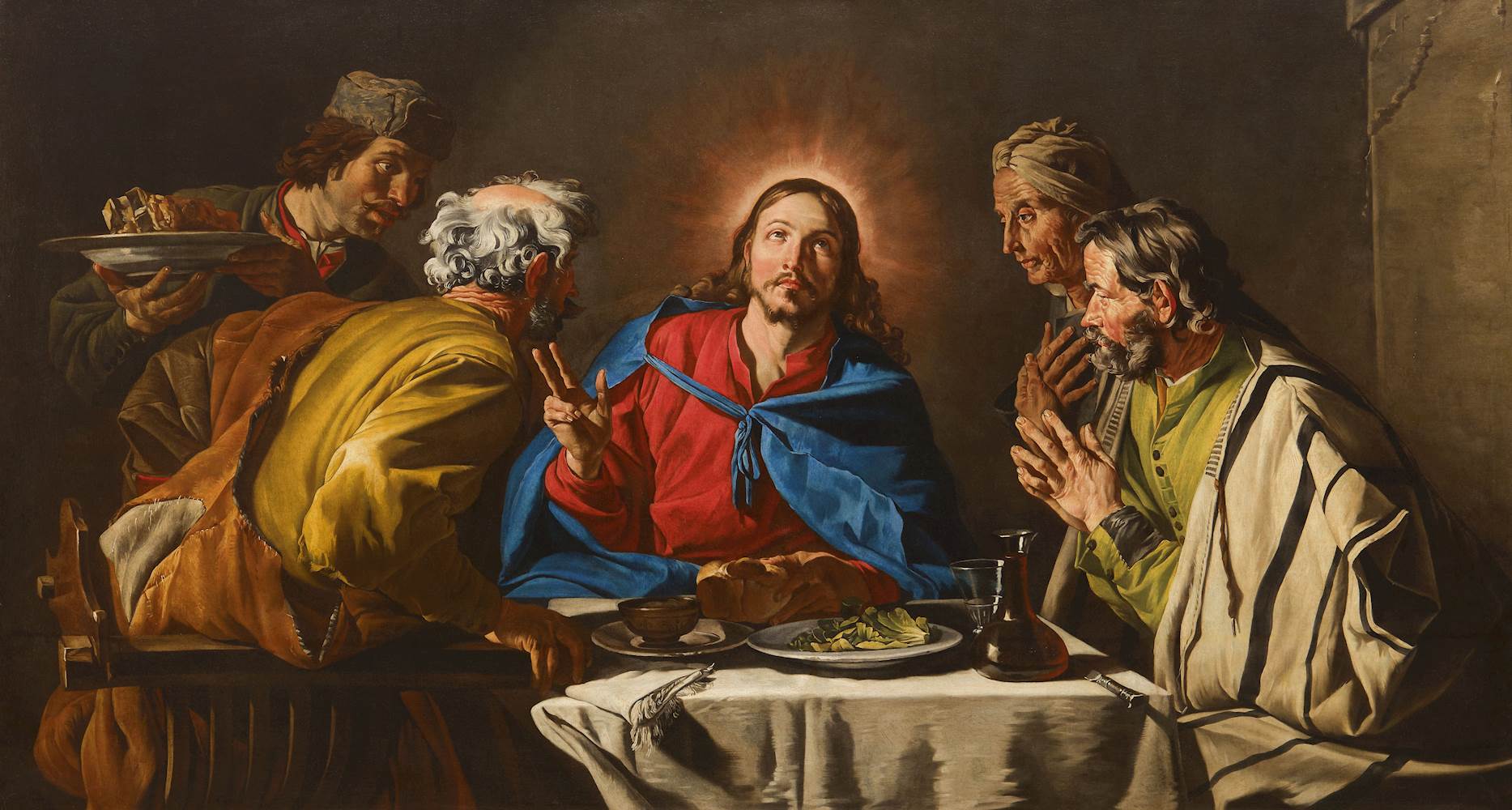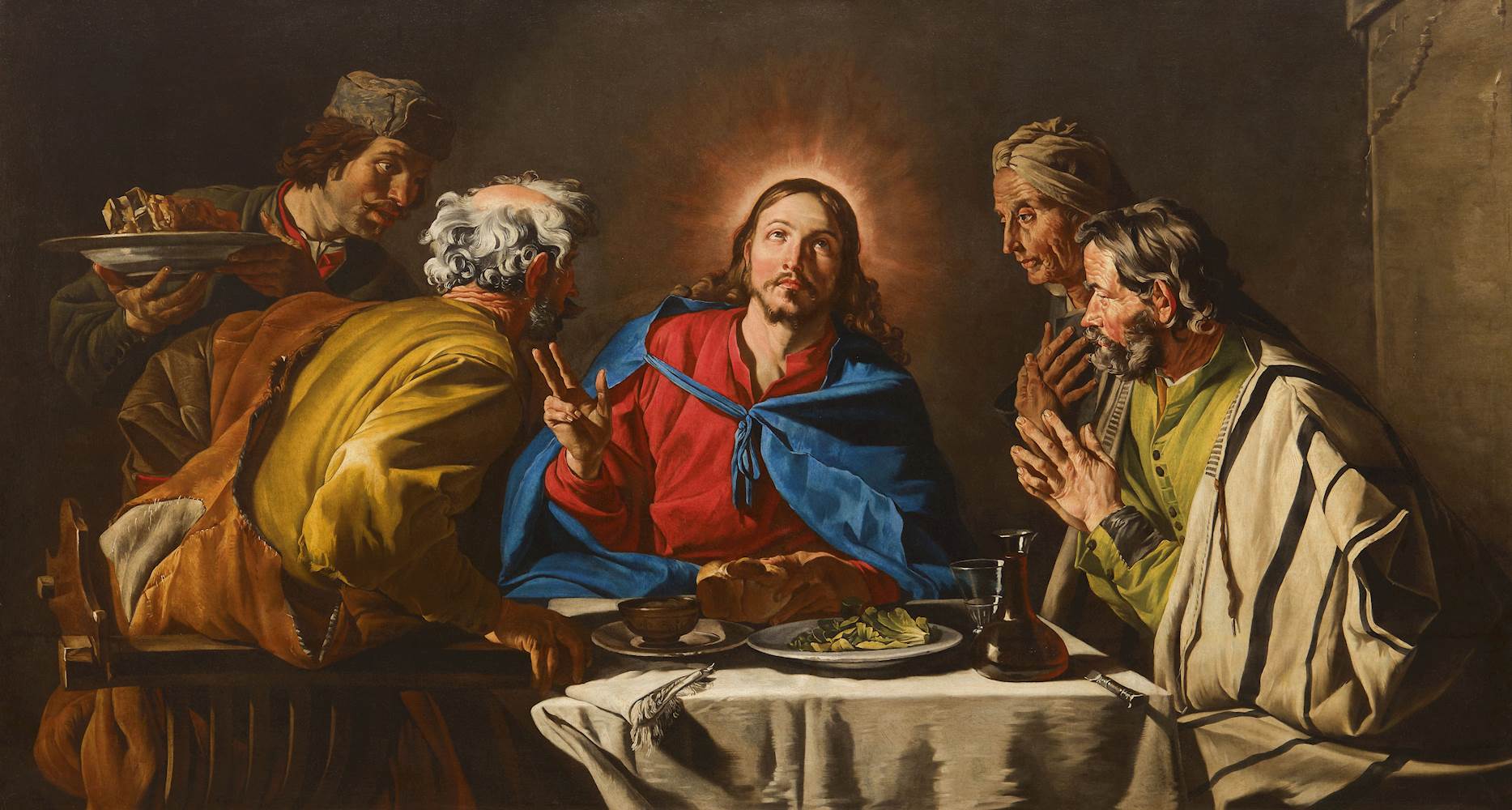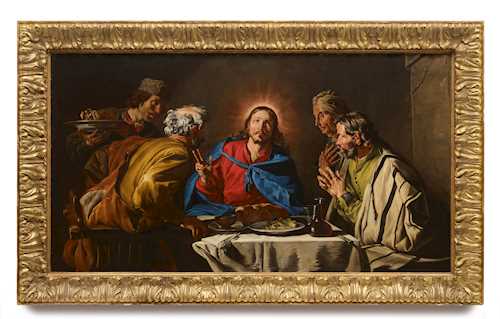
拍品 3020* - A210 大师画作 - Freitag, 20. September 2024, 02.00 PM
MATTHIAS STOMER
(Amersfoort circa 1600–after 1650 Sicily)
The supper in Emmaus. Circa 1640.
Oil on canvas.
126 × 229 cm.
Certificate:
- Maurizio Marini.
- Gert Jan van der Sman, 23.12.2020.
Provenance:
- Private collection, 1951.
- Private collection, 1953–1990.
- With Galerie Bruno Meissner, Zurich, 1991.
- Acquired from the above gallery, private collection, Switzerland.
Exhibited:
- Maastricht 1991, TEFAF, Galerie Meissner, 9.–17.3.1991.
- Lucerne 1994, Gemälde Alter und Moderner Meister, Galerie Fischer Luzern, 27.8–17.9.1994, no. 6.
Literature:
- Domien Roggen: Werk van M. Stomer en Th. Rombouts, in: Gentse Bijdragen tot de Kunstgeschiedenis, XIII, 1951, pp. 270 and 273.
- Henri Pauwels: De Schilder Matthias Stomer, in: Gentse Bijdragen tot de Kunstgeschiedenis, XIV, 1953, p. 153, 186, fig. 3, p. 151.
- Benedict Nicolson: Stomer Brought Up-to-date, in: The Burlington Magazine, vol. 119, no. 889, Special Issue in Honour of Benedict Nicolson, April 1977, p. 241, no. 54 (as “Christ at Emmaus (Christ in the center)”).
- Matthiesen Gallery: Around 1610. The Onset of the Baroque, London-Leicester, 1985, pp. 107–110.
- Leonard J. Slatkes: Die Berufung des Matthäus, in: Holländische Malerei in neuem Licht. Hendrick ter Brugghen und seine Zeitgenossen, exh.cat. Braunschweig, 1986, pp. 334–336, no. 75.
- Maria Teresa Penta: Un’ opra di Matthias Stomer a Napoli, in: Storia dell’arte, 69, 1990, p. 254, footnote 5.
- Benedict Nicolson: Caravaggism in Europe, second edition, revised and enlarged by Luisa Vertova (3 Bd.), Turin 1990, vol. 1, p. 184.
- Exh.cat. Gemälde Alter und Moderner Meister, ed. Galerie Fischer, Lucerne 1994, no. 6 (with ill.).
- Maurizio Marini: L’ultimo caravaggesco. Tre “cene in Emmaus” inedite dell’ olandese Matthias Stomer, tardo seguace del maestro e del naturalismo “a luce di candela”, in: Quadri & sculture, 5, 1997, 27, p. 43, ill. p. 41.
- Gert Jan van der Sman: Naples and Southern Italy: Late Caravaggio and his Followers, in: G.J. van der Sman (ed.): Caravaggio and the Painters of the North, exh.cat. Madrid, Museo Thyssen-Bornemisza, 2016, p. 179, fig. 55 (also mentioned on p. 196 footnote 1, under cat.no. 53; Article by Giuseppe Porzio).
The present work by the Caravaggist Matthias Stomer is notable for the grandiosity of its composition, combined with outstanding painterly execution, revealing the full extent of Stomer's artistic skill. The emphatic gestures, the expressive faces with their wrinkled, leathery skin and the close proximity of the figures, transform this monumental painting into a vivid representation of the biblical episode of the Supper at Emmaus, in which the moment of surprise is given prominence.
The Supper at Emmaus is one of the most important subjects employed during the Catholic Counter-Reformation, which, fuelled by the Council of Trent, introduced a new religious policy and affirmed the real presence of Christ in the Eucharist. Stomer adheres closely to the text of the Gospel of St Luke (Luke 24:30-31), which tells how two disciples encountered Christ on their way to Emmaus, a village near Jerusalem, but did not immediately recognise him. When they reached Emmaus, they urged him to stay and eat with them. During the supper, Christ took the bread, gave thanks, broke it and began to distribute it. It was only then that the disciples' eyes were opened, and they understood that he was the Risen Christ.
The disciple leaning forward casts a strong shadow on the table, which is covered with a variety of objects, using a form of naturalism that was much appreciated by viewers of the time. As Christ blesses the bread, the disciple on the left, visible from behind, is about to leap up from his chair, a motif inspired by Caravaggio's (1571–1610) early depiction of the Supper at Emmaus, which was commissioned by Ciriaco Mattei in 1601 and is now in the National Gallery in London (inv. no. NG 172, see Fig. 1). Caravaggio, who had introduced into painting the use of chiaroscuro - the dramatic representation of light and shadow, and an extremely realistic depiction of saints, made a deep impression on painters from the Netherlands in particular. Stomer also belonged to the circle of Caravaggists in Rome.
This impressive painting offers an exciting interpretation of a theme that was highly valued by Caravaggio and his followers. Stomer himself, who in addition to historical and mythological subjects mainly painted religious motifs, and in particular scenes from the life of Christ, took up the theme of Christ at Emmaus several times around 1633 to 1640 during his stay in Naples and afterwards when he was in Palermo, systematically exploring the potential of different lighting effects. An early version, created around 1635–30, is now in the Museo di Capodimonte in Naples (inv. no. Q197), while another is in the Musée de Grenoble (inv. no. MG82, see Fig. 2).
Whereas 20th century scholarship worked on the assumption that the painting offered here was produced in Rome around 1620–1632 or in Naples around 1633–1639 (see literature), more recent research postulates that it was painted around 1640 during Stomer's Sicilian period. Active in Sicily between 1640 and 1643, Stomer received more generous patronage than ever before, and this period proved to be the most illustrious of his entire career. Typical of the monumental works of this creative phase are the careful distribution of the figures on the picture surface and the use of a broad colour palette, enlivened by a rich impasto accentuation of the faces and hands of the main figures. Stomer’s interest in the art of Peter Paul Rubens (1577–1640) is likely to have had a major influence at this time. Indeed, in the version offered here, Stomer seems to be consciously striving for great clarity and monumentality. In this case, Willem Swanenburg's (1500–1612) engraving after Rubens' "The Supper at Emmaus" from 1611 (Rijksmuseum, inv. no. RP-P-OB-103.683, see fig. 3) may have served as a source of inspiration. The details that most caught Stomer's eye in Rubens' composition were the head of Christ, the background figure of the servant holding a plate, the motif of the heavy cloak hanging over the shoulders of the disciple seated on the right, and the elaborate hairstyle of the disciple on the other side of the table. Stomer very skilfully transposed these elements into his own naturalistic style.
The Utrecht School, a high-calibre source of European Caravaggism, drew its strength from Rome, where Hendrick ter Brugghen (1588–1629), Dirk van Baburen (1595–1624) and Gerrit van Honthorst (1592–1656) studied the master's art. Matthias Stomer, who was one of the most important Dutch painters active in Italy in the first half of the 17th century, also travelled to Rome to study Caravaggio's art. He probably received his training in Utrecht, as the influence of the Utrecht painters Abraham Bloaemart (1564–1651) and Gerrit van Honthorst on his œuvre leads us to assume that Matthias Stomer was a pupil of theirs. By 1630 at the latest, he had travelled to Rome, and is known to have been around thirty years old at the time. Originally travelling to Italy only to study, Stomer never returned to the Netherlands and eventually settled in northern Italy.
"The Supper at Emmaus" is remarkable for the ease with which Matthias Stomer combined his fidelity to Caravaggio's naturalism with his sensitivity to the brio of Rubens' great Baroque style. The painting is an outstanding example of how the last of the great Caravaggists was able to achieve this synthesis with complete mastery and palpable self-confidence.
The painting is archived under nr. 229064 in the RKD, The Hague, as an original work by Matthias Stomer.
The Supper at Emmaus is one of the most important subjects employed during the Catholic Counter-Reformation, which, fuelled by the Council of Trent, introduced a new religious policy and affirmed the real presence of Christ in the Eucharist. Stomer adheres closely to the text of the Gospel of St Luke (Luke 24:30-31), which tells how two disciples encountered Christ on their way to Emmaus, a village near Jerusalem, but did not immediately recognise him. When they reached Emmaus, they urged him to stay and eat with them. During the supper, Christ took the bread, gave thanks, broke it and began to distribute it. It was only then that the disciples' eyes were opened, and they understood that he was the Risen Christ.
The disciple leaning forward casts a strong shadow on the table, which is covered with a variety of objects, using a form of naturalism that was much appreciated by viewers of the time. As Christ blesses the bread, the disciple on the left, visible from behind, is about to leap up from his chair, a motif inspired by Caravaggio's (1571–1610) early depiction of the Supper at Emmaus, which was commissioned by Ciriaco Mattei in 1601 and is now in the National Gallery in London (inv. no. NG 172, see Fig. 1). Caravaggio, who had introduced into painting the use of chiaroscuro - the dramatic representation of light and shadow, and an extremely realistic depiction of saints, made a deep impression on painters from the Netherlands in particular. Stomer also belonged to the circle of Caravaggists in Rome.
This impressive painting offers an exciting interpretation of a theme that was highly valued by Caravaggio and his followers. Stomer himself, who in addition to historical and mythological subjects mainly painted religious motifs, and in particular scenes from the life of Christ, took up the theme of Christ at Emmaus several times around 1633 to 1640 during his stay in Naples and afterwards when he was in Palermo, systematically exploring the potential of different lighting effects. An early version, created around 1635–30, is now in the Museo di Capodimonte in Naples (inv. no. Q197), while another is in the Musée de Grenoble (inv. no. MG82, see Fig. 2).
Whereas 20th century scholarship worked on the assumption that the painting offered here was produced in Rome around 1620–1632 or in Naples around 1633–1639 (see literature), more recent research postulates that it was painted around 1640 during Stomer's Sicilian period. Active in Sicily between 1640 and 1643, Stomer received more generous patronage than ever before, and this period proved to be the most illustrious of his entire career. Typical of the monumental works of this creative phase are the careful distribution of the figures on the picture surface and the use of a broad colour palette, enlivened by a rich impasto accentuation of the faces and hands of the main figures. Stomer’s interest in the art of Peter Paul Rubens (1577–1640) is likely to have had a major influence at this time. Indeed, in the version offered here, Stomer seems to be consciously striving for great clarity and monumentality. In this case, Willem Swanenburg's (1500–1612) engraving after Rubens' "The Supper at Emmaus" from 1611 (Rijksmuseum, inv. no. RP-P-OB-103.683, see fig. 3) may have served as a source of inspiration. The details that most caught Stomer's eye in Rubens' composition were the head of Christ, the background figure of the servant holding a plate, the motif of the heavy cloak hanging over the shoulders of the disciple seated on the right, and the elaborate hairstyle of the disciple on the other side of the table. Stomer very skilfully transposed these elements into his own naturalistic style.
The Utrecht School, a high-calibre source of European Caravaggism, drew its strength from Rome, where Hendrick ter Brugghen (1588–1629), Dirk van Baburen (1595–1624) and Gerrit van Honthorst (1592–1656) studied the master's art. Matthias Stomer, who was one of the most important Dutch painters active in Italy in the first half of the 17th century, also travelled to Rome to study Caravaggio's art. He probably received his training in Utrecht, as the influence of the Utrecht painters Abraham Bloaemart (1564–1651) and Gerrit van Honthorst on his œuvre leads us to assume that Matthias Stomer was a pupil of theirs. By 1630 at the latest, he had travelled to Rome, and is known to have been around thirty years old at the time. Originally travelling to Italy only to study, Stomer never returned to the Netherlands and eventually settled in northern Italy.
"The Supper at Emmaus" is remarkable for the ease with which Matthias Stomer combined his fidelity to Caravaggio's naturalism with his sensitivity to the brio of Rubens' great Baroque style. The painting is an outstanding example of how the last of the great Caravaggists was able to achieve this synthesis with complete mastery and palpable self-confidence.
The painting is archived under nr. 229064 in the RKD, The Hague, as an original work by Matthias Stomer.
STOMER'S DRAMATIC SUPPER
"THE ENTIRE COMPOSITION SIMPLY INVITES THE VIEWER".
Matthias Stomer's brilliant representation of the Supper at Emmaus is a quintessential example of Caravaggio's influence on Northern European painting.
CHF 300 000 / 500 000 | (€ 309 280 / 515 460)


